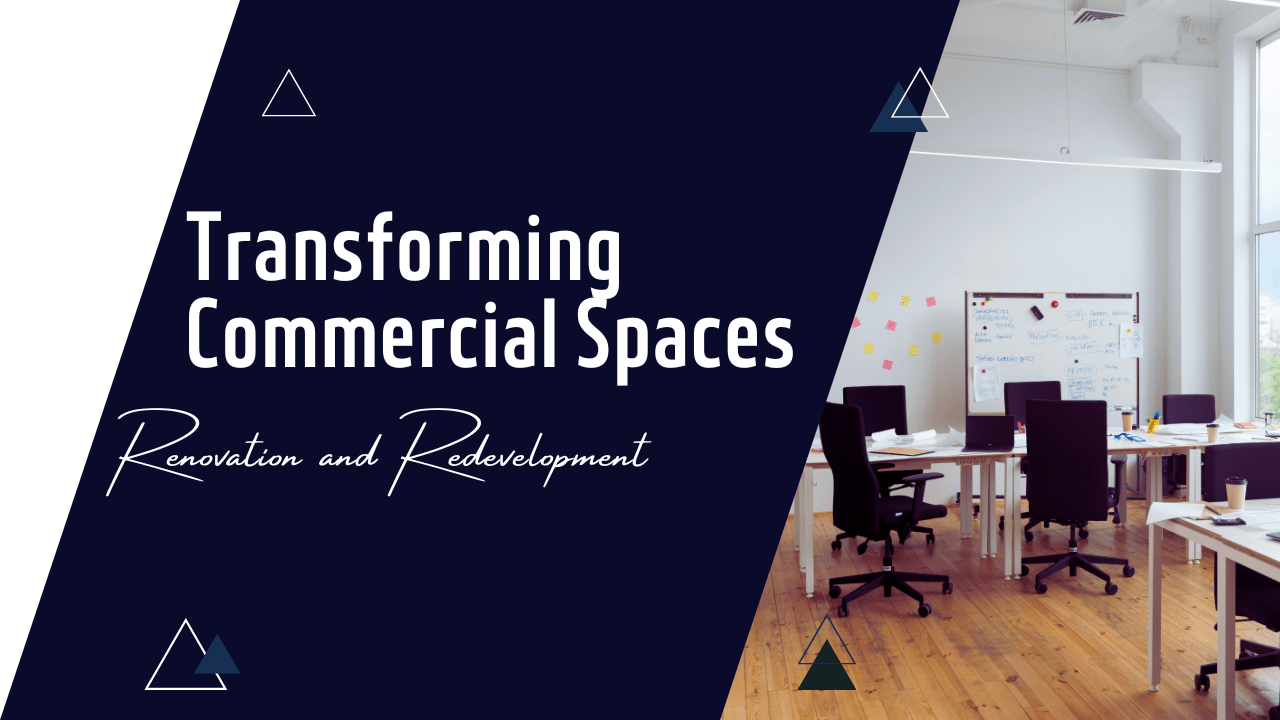At Bell Properties, we manage both commercial and residential real estate, and while we would never consider making renovations to a home that meet a tenant’s specific needs, this is actually pretty normal when we’re talking about Southern California commercial property management. Those commercial tenants you attract to your property will have some specific requirements for their space. These are tenants who are running a business from your property, so they’re going to be extremely particular about how the space is set up to be functional
Before you and your commercial tenant sign a lease agreement, you may have to agree to a set of improvements or renovations.
Transforming commercial spaces is normal and encouraged. You want to give your new tenants exactly the space they need, in the hopes that they’ll stay with you for many years.
Let’s take a look at what you can expect and how to negotiate these renovations.
What is a Commercial Tenant Improvement?
Generally speaking, a commercial tenant improvement (TI), which is often referred to as a commercial leasehold improvement or a build-out, is a set of customized changes or repairs that you indicate you’re willing to make to the commercial property you own in order to rent it out. This will be part of your lease agreement.
It’s a common practice in commercial real estate because property changes are typically needed to fit the unique business needs of the tenant who is moving in. A large, open space, for example, may need to be divided into offices.
New paint, new carpet, and updates to bathrooms or electrical work: these all qualify as tenant improvements. Additional examples might include:
New paint inside the space or outside on the building.
Separating rooms or offices; creating waiting rooms or reception areas.
Adding a parking lot.
Changing or adding lighting or other electrical work.
Furniture is not considered a tenant improvement. It’s up to your tenant to provide the furniture they want or need to run their business.
Paying for Tenant Renovations in Southern California Commercial Space
How are these improvements and renovations paid for? That depends entirely on your lease agreement and what you’ve negotiated with your tenant. In many cases, the property owner or landlord will pay directly for the changes. There are also situations where the tenant will pay but the landlord will reimburse. If you want your tenant to pay for all of the renovations, you should expect to offer reduced rent to your tenant.
You’ll need to discuss the modifications to the property that your tenants need. Those will be incorporated into the lease agreement, as well as information on who pays. It comes down to how the deal is negotiated between you and your tenants.
Turn-key build-outs where the landlord pays
Tenants may not want to pay for improvements to a space that they don’t own. In that case, you’ll pay for the changes and offer them a property that’s renovated to their liking and ready for when they move in. This can save time and money and make the logistics more efficient: you’re in charge.
However, it’s an expense for you as the property owner. You’re making changes for one tenant that may not work for future tenants. Generally, this isn’t a huge drawback because the improvements you make will reflect well on the property ultimately, and raise its value.
Customer-controlled renovations
Maybe your tenant is willing to invest their own money into creating the space that they want. Tenants may control the costs and the process, but any changes to your property still need to be approved by you, and you’ll want to reference this in your lease. Tenants will hire the contractors and vendors in this scenario and stick to their own budget. You may be asked for a tenant improvement allowance in exchange for the tenant’s willingness to pay for renovations.
Usually, costs are shared between the parties in one way or another.
Negotiating Improvements: Southern California Commercial Property Management
When we’re talking about Southern California commercial property management, remember that these tenant improvements and renovations are not required by law. They’re also not restricted by any legal precedent. You can negotiate with them, and your tenants can negotiate, too.
Every commercial lease agreement is written differently. The language around renovations and tenant improvements is likely found under the “Improvements and Alterations” section, or something similarly named. Review that carefully before you agree to any improvements, and encourage your tenants to review it as well.
Many commercial lease agreements will provide for a build-out allowance, and your tenant may be asking for more than what you had initially intended to provide. There are several factors that go into this type of negotiation, including:
The general market. How competitive do you need to be in order to secure your tenant and get the lease signed? If the current commercial real estate market is stronger for tenants, you might find yourself agreeing to more complex renovations and build-outs in order to attract and keep your tenant for longer. However, if there are not a lot of options for the type of commercial space that a potential tenant is looking for, you’re going to have a stronger bargaining position. Make sure you understand the market and how your property fits into it.
The tenant you’re placing. How long can you expect them to be in place, and what kind of market share are they commanding with their own business? If you have a high-value tenant who is willing to sign a 10-year lease, you can likely feel good about allowing the renovations and build-outs that they want. If you’re working with a tenant who is just starting their business and looking for a shorter lease term, you might want to move slower.
Your lease terms. How long will your tenant be in place? If they’re in the space for a long time, you should be more willing to pay for improvements and customizations. Think about their proposed move-in date as well. Delays often occur when the timeline depends on contractors, subcontractors, and vendors.
You’ll want to also negotiate the hierarchy of supervision when it comes to the build-out. Who is actually overseeing the work? If it’s you, as the property owner, make sure the tenant is willing to let you make the decision and call the shots. If you want your tenants to be more involved, make sure you’re willing to hand that control over.
Always be sure that all parties understand who is paying and how that payment will be made. Whether it’s a shared expense or yours entirely, you want to make sure those payment terms are spelled out in your lease agreement as well as any other contractual documents that pertain to this work.
Review the lease agreement you’re presenting to your tenant and consider all of these factors before you put together a strategy for negotiating the renovations. You want to have everything in place before the work starts, otherwise there can be confusion and conflict once that work is underway.
Getting the Work Done with Bell Properties
As your Southern California commercial property management partner, Bell Properties will put together a plan for ensuring the work is done to your tenant’s specifications, without sacrificing the condition or value of your property.
Here are some of the things at Bell Properties we are particularly careful about when managing your renovations and build-outs.
Bell Properties works with the best contractors and vendors in Southern California. We’re happy to gather quotes in order to ensure that you’re not paying more than you need to, but our preferred vendors give us the best discounts thanks to the volume of work we provide. Once you and your tenants are clear on a plan and a budget, we’ll execute it, and our contractors will be ready to get to work. While saving money is our goal, we know that cheap work isn’t always great work. We’ll show you why we want to work with the professionals that we hire.
We take care of all the project management. This includes scheduling projects, preparing the property for the work that’s about to start, overseeing the purchasing of materials and the gathering of any necessary permits. If demo work is required before construction begins, we’ll supervise that as well. Maybe you’re just making a few simple cosmetic updates for your commercial tenants; we can oversee small projects, too.
With help from Bell Properties, you’re working with an experienced team that will handle the entire remodeling process, from the design and planning stages to the budgeting, the actual work, and then the post-renovation cleanup. We’ll keep you informed every step of the way, but there’s nothing you have to do that’s hands-on. The actual renovation and remodel will be handled by us. We can streamline workflows and communications and bring about the desired result quickly and to everyone’s satisfaction.
Different types of spaces require different types of renovation. The changes you make to an office building will be far more different than the changes that are made to a small retail shop or a large industrial nuance.
 Working with a Southern California commercial property management company can make this process a lot more efficient and manageable. Contact us at Bell Properties Commercial Real Estate. We can provide expertise and leadership to your commercial space.
Working with a Southern California commercial property management company can make this process a lot more efficient and manageable. Contact us at Bell Properties Commercial Real Estate. We can provide expertise and leadership to your commercial space.



